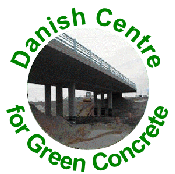Centre for Green Concrete - Introduction
Concrete is used in large quantities and is probably the world's most important construction material. In Denmark alone, about 8 million tonnes of concrete are used annually, corresponding to 1.5 tonnes per capita (year 2000 production figures). Concrete is generally speaking an environmental friendly material since it is made of natural, raw materials available in large quantities world-wide |
The Danish cement and concrete industry has made a considerable effort to reduce the environmental impact of cement and concrete production throughout the 1990ies. However, since the consumption of concrete is rather high, there are many good reasons to continue making concrete constructions even more sustainable. These are som of the reasons why a number of companies joined forces to establish the Centre for Resource Saving Concrete Structures in 1998.
In the period 1998-2002, a number of leading companies worked together to create new knowledge about environmental friendly types of concrete, and to develop green technologies for concrete structures. Furthermore, the cooperation was aiming to promote the use of green concrete technologies in modern construction projects. It was also an opportunity to give the Danish cement and concrete industry a competitive edge in the international market, based on new technologies for the production and use of environmental friendly types of concrete.
This resulted in a 4-year project entitled the Centre for Resource Saving Concrete Structures - also known as the Danish Centre for Green Concrete or simply Green Concrete.
The Centre was co-financed by the parties involved in the project, and by the Danish Ministry of Science, Technology and Innovation. The total budget was DKK 22.5 million. The participants represented all the links of the supply chain, ranging from the production of cement, aggregates and concrete, via research, development and consultancy to contractors and building owners.
